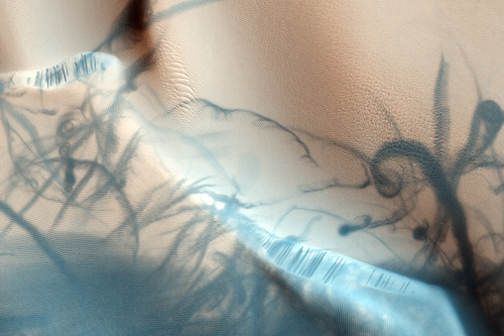Dust devils on Mars!

Image credit: Image: NASA/JPL/University of Arizona
image home: http://www.uahirise.org/science_themes/aeolian.php
What does this image look like to you? Could it be a close up of a tattoo or a lizard’s back or even silly putty that was rubbed on a news paper? Nope, none of the guesses above are as amazing as the correct answer. This image was taken by HiRISE camera onboard the Mars Reconnaissance Orbiter. The resolution of the photos taken by HiRISE is less than a meter which means that you could identify the trunk of an elephant walking on Mars. In addition to learning more about the Martian surface, the orbiter also helps researchers choose a safe landing spot for future exploration missions.
The dark tracks swirling through the image are the paths left behind from large dust devils. Dust devils look like small tornados and operate like thermodynamic heat engines. They swallow hot air near the surface and spiral it up creating a spectacular dusty vortex. As the hot air rises it soon expands and cools. The cool dense air then falls down the center of the vortex. Dust devils are commonly found on Mars and in Southern Arizona.
Dr. Nilton Renno and Dr. Jasper Kok from the University of Michigan are experts on desert and Martian dust devils. Their research studies how dust devils scatter dust in to the atmosphere and how it affects the climate. However, they also look into how dust devils create static electricity and lightning! Yes that’s right: lightning. What was typically thought of as a harmless vortex in the desert turns how to possess some high voltage awesomeness. Mars really knows how to put on an atmospheric show and from the looks of the HiRISE images, these spectacular events are common.
Links:
Dust devils create lightning! PRL paper:
http://sitemaker.umich.edu/jasperkok/files/kokrennoprl2008.pdf
Video of a dust devil in Southern Arizona:
http://sitemaker.umich.edu/jasperkok/files/dustdevil_sonorandesert_2005.mpg











